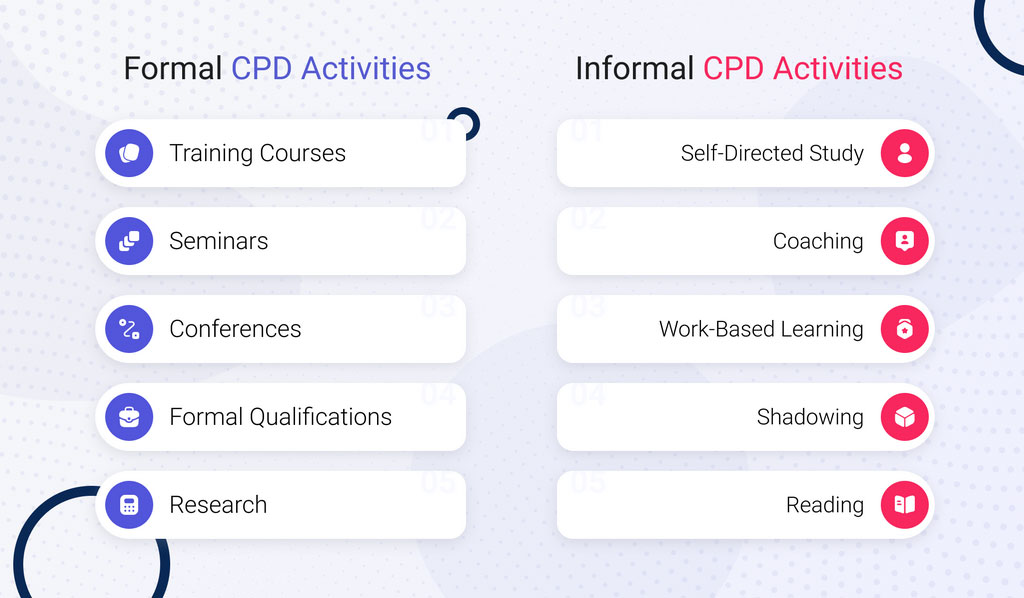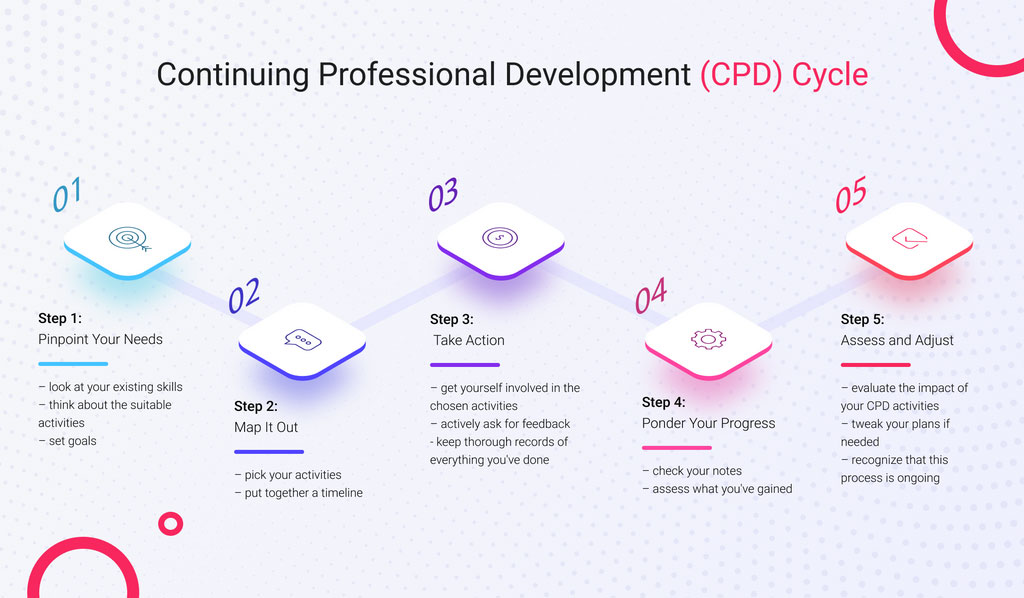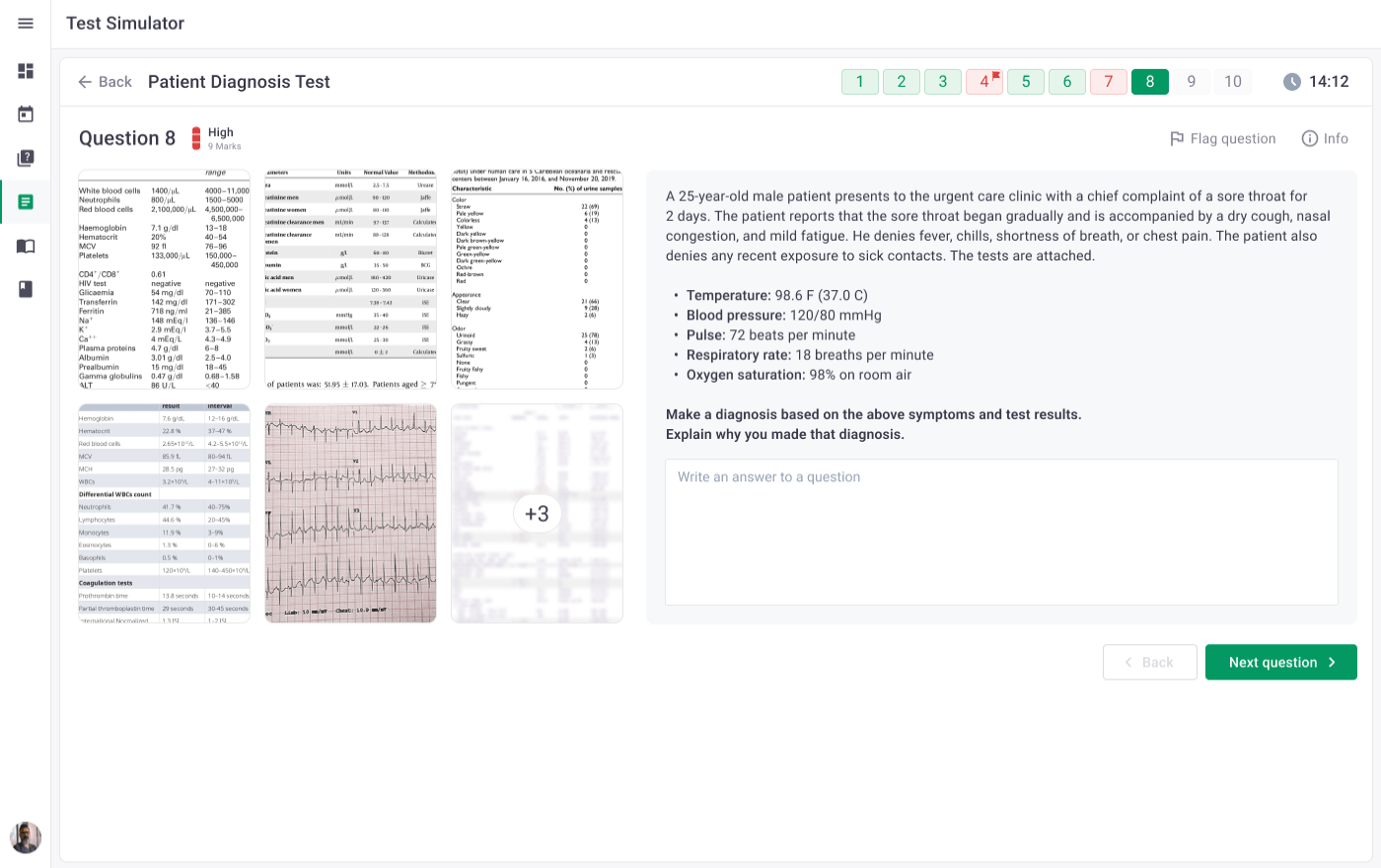Summary
Continuing Professional Development (CPD) is essential for professionals across various industries to maintain and enhance their skills in today’s rapidly evolving landscape. CPD encompasses both formal and informal learning activities, from structured training sessions and workshops to more casual learning moments, like reading articles or engaging in discussions with colleagues. Embracing CPD ensures that professionals stay sharp in their respective fields, adapt to new changes, and foster personal and professional growth.
In today’s rapidly evolving professional landscape, staying ahead requires more than just foundational knowledge. Continuous growth and adaptation are other factors that should be included in the list. That is why Continuous Professional Development (aka CPD) has emerged as a crucial strategy for professionals across various industries to maintain and enhance their skills. And with the advent of digitalization, the approach to CPD has transformed, making learning more accessible and tailored to individual needs.
It doesn’t matter which industry your business is in, because any company’s staff may require training in order to keep employees up-to-date with the changes. Therefore, this time, we decided to explore the significance of the CPD approach, the impact of online learning that comes along, the necessity of training and certification in diverse fields, and how modern tools can support this ongoing journey of professional excellence. So, buckle up and let’s dive deeper!
Continuing Professional Development (CPD) and Its Role in Operations Management
It is all about the ongoing journey of learning and growth that professionals dive into to keep their skills fresh and their knowledge current. The main aim is to make sure that experts stay sharp in their respective fields. It’s a lifelong adventure that not only helps you adjust to new changes but also fosters personal and professional growth. CPD includes a variety of activities, ranging from structured training sessions and workshops to more casual learning moments, like reading articles or chatting with coworkers.
To break it down, CPD activities can be categorized into formal and informal types. Let’s explore some examples of what each category might involve.

It all depends on how the activities are structured and implemented. For example, mentoring and coaching can be considered both formal and informal CPD activities. If there is a structured program with specific goals, training sessions, and documentation, the process falls under formal CPD. If there are just casual ad-hoc interactions, such as spontaneous advice or peer support, they are considered informal CPD.
The key distinction between formal and informal Continuing Professional Development activities is how they’re organized and presented. Both forms of CPD play an important role in enhancing professional skills, with formal CPD offering a more organized approach to learning, while informal learning allows for a more tailored and adaptable experience. Now, let’s dive deeper into each type.
Formal Learning
This type of learning involves organized activities with clear objectives and outcomes. Overall, the process includes enrollment in degree programs, certification courses, or other structured educational programs to gain in-depth knowledge and qualifications in the particular field. Participation in these activities can often be documented and verified, such as through certificates of attendance.
- Workshops and seminars. This activity allows employees to participate in interactive sessions focused on specific skills or knowledge areas, often involving hands-on activities and group discussions.
- Conferences. Attending or presenting at industry events where professionals gather to share the latest research, trends, and best practices, and to network with peers is another good way to improve your professional knowledge.
- E-learning training courses. Engaging in structured professional development courses for employees, either in-person or online, that offer flexibility and a wide range of topics allows employees to learn at their own pace from anywhere.
- Participation in projects. Another activity includes gaining practical experience and new skills by working on projects, either within the organization or through external opportunities, often involving collaboration and problem-solving.
- Formal qualifications. Pursuing degrees, certifications, or other recognized qualifications is also a part of formal learning. These qualifications typically involve structured learning with clear objectives and outcomes, such as degree programs, certifications, and professional accreditations. They provide documented evidence of your learning and are often recognized by professional bodies and employers.
- Research. Engaging in research activities often involves structured learning with clear objectives and outcomes. This can include conducting original research, publishing papers, or participating in research projects.
- Volunteering. Contributing time and skills to community service or non-profit organizations, which can provide valuable experience, enhance your skill set, and offer opportunities for personal and professional growth.
Informal Learning
As for the informal type of CPD, it involves self-directed activities that are often more flexible and less structured. Typically, it is harder to document these activities, but keeping personal records and self-evaluation can help.
- Self-directed study. The goal for this activity is to take the initiative to learn independently through various resources, such as online tutorials, videos, and practice exercises.
- Reading. Keeping up-to-date with the latest developments in your field by reading books, professional journals, articles from specialists in your field, and other professional literature is another way to participate in informal learning.
- Work-based learning. It involves learning that occurs naturally through daily work activities, problem-solving, and interactions with colleagues. For example, reflecting on work experiences, receiving feedback from peers or supervisors, and learning new skills through job rotations is the part of informal work-based learning.
- Shadowing. It is all about picking up new skills and techniques by casually observing your coworkers and chatting with them. It’s a great way to get a feel for different roles in the workplace without any formal setup.
- On-the-job training. involves learning as you go, tackling daily tasks, getting feedback from your peers, and figuring things out in real-time. It’s a hands-on approach that helps you grow and adapt in your role.
Read Also How to Design Effective Multiple-Choice Questions for Computer Science Exams
How Digital Age Broke the Mold of Established CPD Conventions
The digital age has totally revolutionized CPD, offering a ton of learning options that are more accessible and flexible than ever. Online learning platforms are now powerful tools, packed with courses that professionals can tackle at their own pace. It allows individuals to juggle their professional development with personal and work commitments without breaking a sweat.
But that’s not all! This digital shift has also made CPD way more inclusive, allowing professionals from all corners of the globe and with different schedules to dive into continuous learning.
Plus, digital tools make it a breeze to track and document your CPD activities. You can easily record your progress and achievements, making your professional development more structured and effective. And the best part? These measurable outcomes can give your career a serious boost.
Read Also The Test of Time: How Online Platforms Reshape Traditional Educational Assessments
Mastering Professional Growth by Understanding the CPD Cycle
If you’re looking to boost your skills or enhance the expertise of your team, you might be wondering where to kick things off. No need to stress; we can break it down step by step.
The continuing professional development (CPD) cycle is a great framework that guides professionals in organizing, implementing, and assessing their learning experiences. By following this structured plan, you can ensure that your development activities are not only organized but also truly impactful.

Step 1. Pinpoint Your Needs
To kick things off, take a good look at your existing skills and knowledge. Jot down everything you’re already good at and pinpoint any areas where you might be lacking. Think about the activities, resources, and ways of learning that could help you fill those gaps. After that, it’s time to set some goals by figuring out what you want to accomplish with your continuing professional development activities.
Step 2. Map It Out
The following step is to pick your activities. Go for the ones that align with the goals you established before. This could involve taking courses, attending workshops, diving into some reading, or getting hands-on experience. Jot down all the activities that catch your interest. After that, put together a timeline by mapping out a schedule to tackle these activities.
Step 3. Take Action
It’s time to dive into the learning process! The Act stage is super important because it turns your ideas into real actions. Your main focus should be on getting involved in the chosen CPD activities and putting your new knowledge and skills to work in your job. Stay adaptable and be ready to embrace new learning chances that might pop up out of nowhere. Also, make sure to actively ask for feedback from colleagues, mentors, or supervisors to boost your learning journey. And remember to keep thorough records of everything you’ve done, like dates, results, and any certificates or proof of participation you’ve earned.
Step 4. Ponder Your Progress
Once you’ve gone through a thorough learning process, it’s time to assess what you’ve gained. Take a moment to think about the knowledge you’ve acquired and how it has influenced your work. The notes you took earlier will help steer you in the right direction.
Step 5. Assess and Adjust
Finally, it’s time to take a look at how well your CPD activities have helped you reach your goals. If you feel like you could use some extra training, tweak your plans according to what you’ve assessed. Remember, nothing is flawless, especially on the first go, so don’t get discouraged; you’ve gained valuable insights from the experience. It’s crucial to recognize that this process is ongoing, helping professionals continually grow and keep up with the latest trends in their industry.
Read Also When “Softer” Means “Stronger”. The Importance of Soft Skills for Software Development Team Members
The Importance of Employee Training and Certification Across Industries
What do businesses from any sector have in common? It is impossible to grow for a long time alone without the help of specialists in different spheres. And the chances increase if your employees keep up with the industry-specific changes and maintain their professional licenses or certifications.
For starters, employee assessment makes sure that employees have the right skills and knowledge to do their jobs well, tailored to their specific industry. Moreover, training programs can significantly improve employee satisfaction and retention. When companies show they’re invested in their team’s growth and career development, it boosts morale and creates an environment where continuous improvement and innovation thrive. Plus, having certified employees can enhance the organization’s credibility, which in turn builds client trust and strengthens the company’s reputation. By focusing on training and certification, businesses can cultivate a skilled, motivated, and dedicated workforce that contributes to long-term success.
- Information Technology. The fast-paced nature of the IT industry, where rapid technological advancements are the norm, necessitates regular training to keep up with new technologies and methodologies. Certifications in specific technologies or practices can significantly enhance an employee’s expertise and career prospects and give them a broader perspective on how to use IT project management software and manage IT teams effectively.
- Healthcare. Staying updated with the latest medical practices and technologies can directly impact patient outcomes. Therefore, regular training on new medical equipment, updated protocols for patient care, and continuous education on emerging diseases is a must. Having a medical professional testing system in your organization will be a wise solution in this case, as with its help, medical professionals will be able to enrich the company’s knowledge base and test their skills.

Source: Medical Professional Testing System
- Finance. In the finance industry, ongoing training helps professionals to stay compliant with regulatory changes and enhances their ability to manage financial risks effectively. Providing employees with CPD training also keeps financial professionals informed about new financial instruments and market trends. For example, a company may offer attending seminars on regulatory compliance, courses on new financial products, and workshops on market analysis techniques.
- Law. All legal professionals have to be aware of changes in legislation, case law, and legal practices, which is why they can’t omit engaging in training activities. For example, they can participate in continuing legal education (CLE) courses, seminars on recent legal developments, and workshops on specialized areas of law.
- Construction. In order to ensure that construction professionals are knowledgeable about new building materials, construction techniques, and safety regulations, companies encourage their employees to also participate in CPD activities. Having only good instruments and construction project management systems may be not enough. That is why construction specialists can choose to train on sustainable building practices, participate in workshops on advanced construction techniques, and sign up for courses on safety compliance.
- Manufacturing. Employees can benefit from training programs on the latest manufacturing techniques, lean manufacturing principles, and the use of advanced machinery and automation tools and manufacturing software solutions. Additionally, workshops on workplace safety and courses on quality management systems can help to ensure that employees perform manufacturing processes efficiently and safely.
- Education. For educators, professional elearning is essential to adopt new teaching methods, educational technologies, and curriculum changes, ensuring they can provide the best possible education to their students. Thus, continuing professional development courses for teachers may include participating in workshops on innovative teaching strategies, courses on digital tools for education, seminars on curriculum development, and using EdTech software. For example, by integrating Examarius into the CPD programs, organizations can ensure that their employees are not only learning but also effectively demonstrating their knowledge and skills through rigorous assessments.
- Engineering. For engineers, it is vital to be updated with the latest technological advancements, safety standards, and industry best practices. They are able to follow their training with the use of engineering software, workshops on safety protocols, and courses on emerging engineering technologies.
- Marketing. Helping marketing professionals to stay current with digital marketing trends, consumer behavior insights, and new marketing tools is also important. Thus, companies can offer marketing specialists the courses on social media marketing, workshops on consumer psychology, and training on the latest marketing analytics tools. As a result, they will be able to create better strategic decisions and use marketing project management systems more efficiently.
Read Also Optimizing Field Operations: The Role of Workforce Management Systems in Energy and Utilities
Conclusion
The rise of online learning and digital resources has significantly improved the accessibility and effectiveness of continuous professional development, providing valuable advantages for both employees and organizations across diverse sectors. By utilizing advanced online testing software and e-learning platforms, companies can optimize their CPD initiatives, ensuring their teams remain proficient, informed, and competitive in the marketplace.
For businesses aiming for growth, engaging in training and certification is not just beneficial; it’s essential. If your organization is in search of an effective software solution to support its development needs, contact us. We are here to assist you in creating a tailored system that meets your specific requirements.